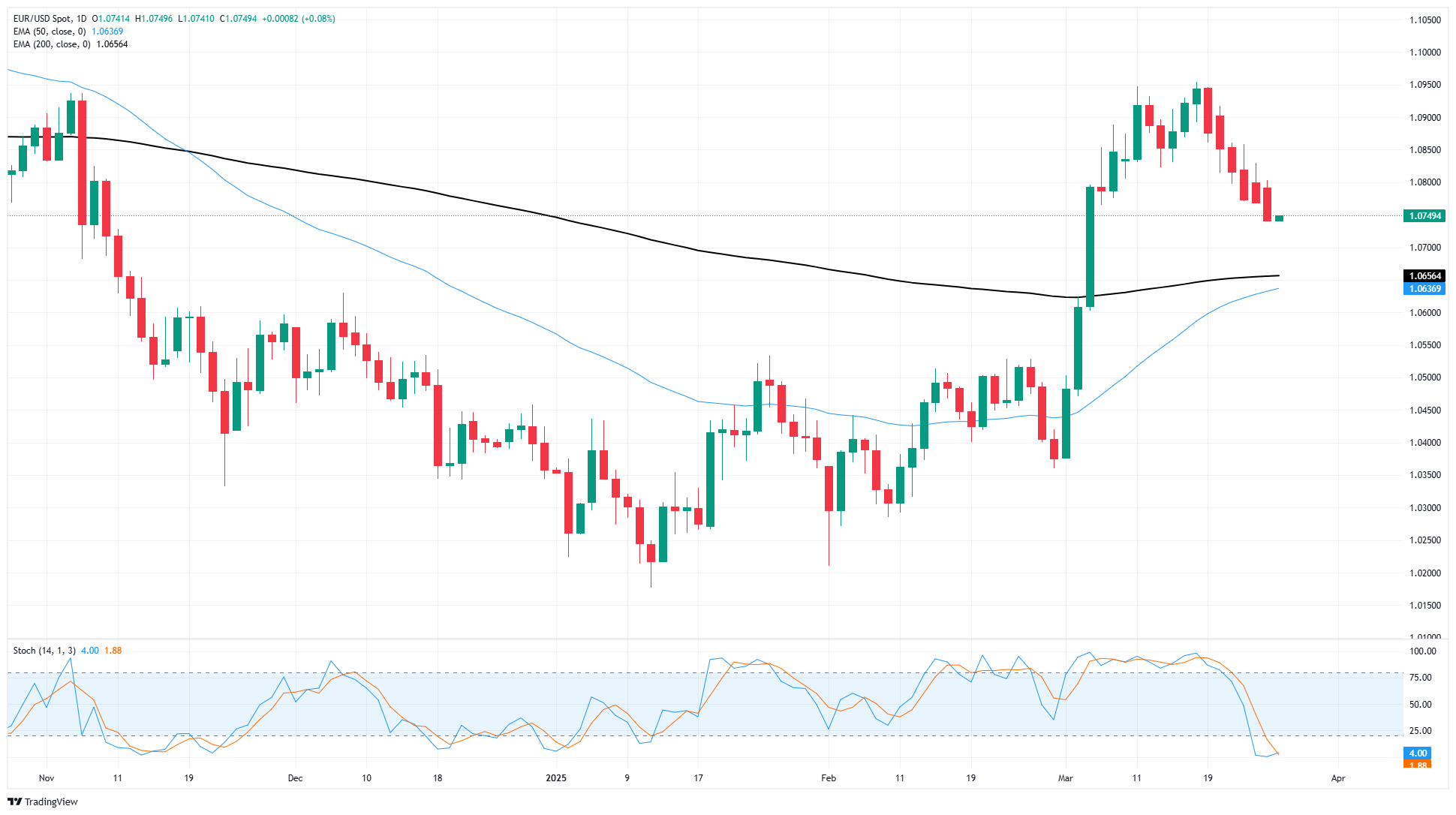Created
: 2025.03.27














![]() 2025.03.27 09:08
2025.03.27 09:08
EUR/USD accelerated to the downside on Wednesday, shedding over one-quarter of one percent on Wednesday and skidding back below 1.0750 for the first time since the first week of March. The pair has lost ground for six straight trading days, and souring market sentiment on trade war fears is poised to take more bites out of risk appetite in the days to come as we get closer to April 2.
President Trump plans 25% tariff on imported vehicles
According to various avenues of information, the Trump administration still plans to move ahead with a wide tariff on all copper imports into the US, matching the Trump team's recent 25% flat import tax on all steel and aluminum that cross the US border. President Trump also intends to announce additional tariffs on automobiles across the board, and European Union (EU) officials are expecting the Trump administration to announce a tariff of around 20% on all, or most, or a targeted group of goods, depending on what day it is and how Donald Trump is feeling at that time.
Fed's Musalem expects inflation back to 2% by 2027
All of this may or may not be in addition to the anticipated "reciprocal" tariff package that President Trump intends to kick off on April 2, which countries may or may not be able to get exemptions from. Donald Trump intends to impose a matching tariff on other countries that have their own trade barriers on US goods, a rather perplexing approach to trade in general. President Trump has also floated the idea of classifying VAT, or luxury taxes, as a kind of pseudo-tariff on US goods, and including those in reciprocal tariffs.
US GDP growth figures are due on Thursday, but the non-preliminary print is unlikely to drive much momentum in either direction. This week's key US data release will be Core Personal Consumption Expenditure Price Index (PCE) inflation due on Friday. Investors will be hoping that a recent upturn in inflation figures will prove to be temporary, but median forecasts are expecting annualized PCE inflation to rise to 2.7% YoY in February.
Six days of steady declines are taking their toll on EUR/USD, as bids slide nearly 2% top-to-bottom from last week's peak just above 1.0950. Bearish momentum has taken hold, and price action is poised to make a fresh push into the 200-day Exponential Moving Average (EMA) just south of the 1.0700 handle.

The Euro is the currency for the 19 European Union countries that belong to the Eurozone. It is the second most heavily traded currency in the world behind the US Dollar. In 2022, it accounted for 31% of all foreign exchange transactions, with an average daily turnover of over $2.2 trillion a day. EUR/USD is the most heavily traded currency pair in the world, accounting for an estimated 30% off all transactions, followed by EUR/JPY (4%), EUR/GBP (3%) and EUR/AUD (2%).
The European Central Bank (ECB) in Frankfurt, Germany, is the reserve bank for the Eurozone. The ECB sets interest rates and manages monetary policy. The ECB's primary mandate is to maintain price stability, which means either controlling inflation or stimulating growth. Its primary tool is the raising or lowering of interest rates. Relatively high interest rates - or the expectation of higher rates - will usually benefit the Euro and vice versa. The ECB Governing Council makes monetary policy decisions at meetings held eight times a year. Decisions are made by heads of the Eurozone national banks and six permanent members, including the President of the ECB, Christine Lagarde.
Eurozone inflation data, measured by the Harmonized Index of Consumer Prices (HICP), is an important econometric for the Euro. If inflation rises more than expected, especially if above the ECB's 2% target, it obliges the ECB to raise interest rates to bring it back under control. Relatively high interest rates compared to its counterparts will usually benefit the Euro, as it makes the region more attractive as a place for global investors to park their money.
Data releases gauge the health of the economy and can impact on the Euro. Indicators such as GDP, Manufacturing and Services PMIs, employment, and consumer sentiment surveys can all influence the direction of the single currency. A strong economy is good for the Euro. Not only does it attract more foreign investment but it may encourage the ECB to put up interest rates, which will directly strengthen the Euro. Otherwise, if economic data is weak, the Euro is likely to fall. Economic data for the four largest economies in the euro area (Germany, France, Italy and Spain) are especially significant, as they account for 75% of the Eurozone's economy.
Another significant data release for the Euro is the Trade Balance. This indicator measures the difference between what a country earns from its exports and what it spends on imports over a given period. If a country produces highly sought after exports then its currency will gain in value purely from the extra demand created from foreign buyers seeking to purchase these goods. Therefore, a positive net Trade Balance strengthens a currency and vice versa for a negative balance.
![]()
Created
: 2025.03.27
![]()
Last updated
: 2025.03.27

FXStreet is a forex information website, delivering market analysis and news articles 24/7.
It features a number of articles contributed by well-known analysts, in addition to the ones by its editorial team.
Founded in 2000 by Francesc Riverola, a Spanish economist, it has grown to become a world-renowned information website.
We hope you find this article useful. Any comments or suggestions will be greatly appreciated.
We are also looking for writers with extensive experience in forex and crypto to join us.
please contact us at support@myforex.com.
Disclaimer:
All information and content provided on this website is provided for informational purposes only and is not intended to solicit any investment. Although all efforts are made in order to ensure that the information is correct, no guarantee is provided for the accuracy of any content on this website. Any decision made shall be the responsibility of the investor and Myforex does not take any responsibility whatsoever regarding the use of any information provided herein.
The content provided on this website belongs to Myforex and, where stated, the relevant licensors. All rights are reserved by Myforex and the relevant licensors, and no content of this website, whether in full or in part, shall be copied or displayed elsewhere without the explicit written permission of the relevant copyright holder. If you wish to use any part of the content provided on this website, please ensure that you contact Myforex.
Myforex uses cookies to improve the convenience and functionality of this website. This website may include cookies not only by us but also by third parties (advertisers, log analysts, etc.) for the purpose of tracking the activities of users. Cookie policy